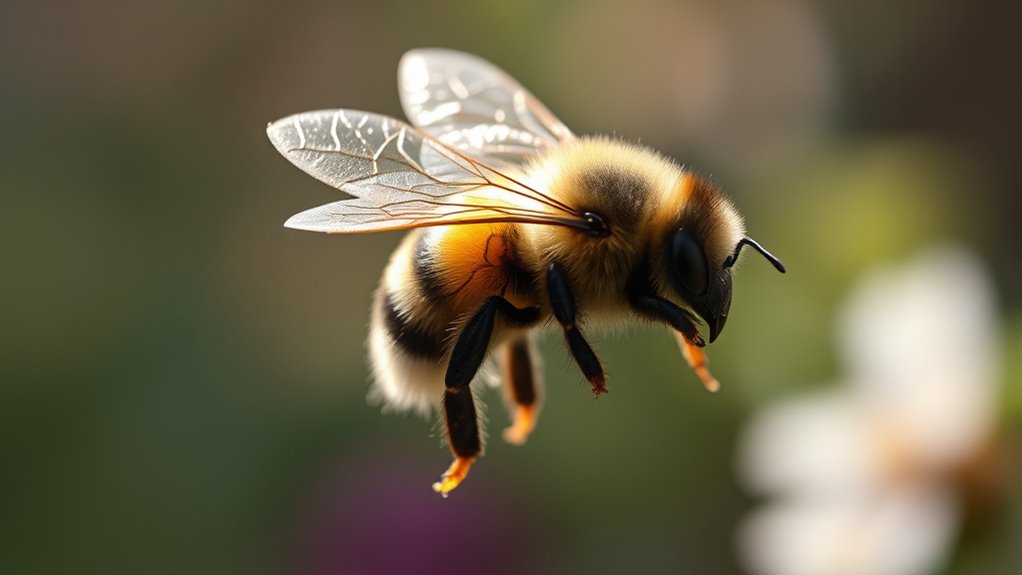Engineers uncover the hidden math behind bumblebee flight by studying their unsteady aerodynamics, like vortex formation and rapid wing motions that generate lift more efficiently. Bees flap their wings at high speeds, creating swirling air currents that stay attached longer, boosting their agility and energy efficiency. By copying these natural strategies—especially vortex control and wing kinematics—engineers develop tiny flying robots called MAVs. Stay tuned to explore how these insights can transform future flight technology.
Key Takeaways
- Bumblebee flight relies on unsteady aerodynamics, involving vortex creation and delayed airflow separation for lift.
- Engineers mimic these principles by designing flapping-wing micro aerial vehicles that generate controlled vortices.
- Precise wing kinematics, including rapid flapping and subtle rotations, are key to replicating bumblebee lift efficiency.
- Vortex attachment and manipulation are central mathematical concepts enabling agile, energy-efficient flight in both bees and MAVs.
- Studying bumblebee aerodynamics reveals mathematical models that inspire advanced, bio-inspired flying robot designs.

Have you ever wondered how bumblebees manage to stay airborne despite their seemingly awkward body size and wing structure? It’s a fascinating question that has intrigued scientists and engineers alike. The secret lies in their mastery of aerodynamic principles and wing kinematics, which allow them to generate enough lift to defy expectations.
Unlike airplanes, which rely on steady, high-speed airflow over fixed wings, bumblebees utilize rapid, complex wing movements that create unsteady airflow patterns. These patterns produce additional lift through phenomena like delayed stall and vortex generation, making their flight highly efficient despite their bulk.
Bumblebees use rapid wing movements and vortex creation for efficient, unsteady flight despite their bulky bodies.
Understanding these principles requires examining their wing kinematics closely. Bumblebees flap their wings at incredibly high frequencies—sometimes over 200 beats per second—and with a unique motion that combines both flapping and subtle rotational movements. This combination isn’t random; it’s precisely tuned to maximize lift.
As their wings flap, they generate a series of vortices—swirling air currents—that stay attached to the wing surfaces longer than in conventional flight. These vortices boost the airflow over the wings, creating more lift than steady airflow alone could produce. This unsteady aerodynamic environment is key to their ability to hover, maneuver quickly, and even take off from a standstill.
From an engineering perspective, these insights into wing kinematics are groundbreaking. Researchers have studied bumblebee flight and decoded the complex interactions of wing motion and airflow, translating these into bio-inspired designs. Micro aerial vehicles (MAVs) now incorporate flapping-wing mechanisms that mimic bumblebee wing movements, aiming to replicate their agility and energy efficiency.
Engineers are experimenting with adjustable wing angles, rapid flapping, and vortex control to improve stability and lift in small flying robots. The goal is to harness the same unsteady aerodynamic principles that bumblebees use naturally.
In essence, bumblebees demonstrate that flight isn’t just about size or power; it’s about how you move through the air. Their mastery of aerodynamic principles through precise wing kinematics shows that even seemingly awkward bodies can achieve remarkable flight capabilities. Additionally, ongoing research into these mechanisms continues to reveal key aerodynamic principles that could revolutionize future flying technologies.
Frequently Asked Questions
How Do Bumblebees Adjust Wing Angles During Flight?
You notice that bumblebees adjust wing angles during flight through angle modulation and wing flexibility. They actively change the pitch of their wings to generate different lift and thrust levels, allowing precise maneuvering.
Their wings are flexible, which helps fine-tune these adjustments, making their flight highly efficient and adaptable. By controlling wing angles dynamically, bumblebees navigate complex environments and maintain stability even in turbulent air currents.
What Role Does Air Viscosity Play in Bumblebee Aerodynamics?
Imagine the gentle whisper of air viscosity guiding bumblebees’ flight, subtly influencing their wing movements. You’ll find that air viscosity affects airflow resistance, which in turn helps bumblebees generate lift and maneuver efficiently. It’s like nature’s way of fine-tuning flight, where the thickness of the air plays a vital role.
Can Bumblebee Flight Patterns Change With Weather Conditions?
You notice that bumblebee flight patterns can change with weather conditions. Wind patterns influence how they navigate and maintain stability.
Temperature fluctuations affect their wing muscle performance. On windy days, they might fly lower or take more direct routes to conserve energy.
When it’s colder, bumblebees might reduce activity or adjust their wing beats to stay warm, showing their remarkable ability to adapt to changing weather factors.
How Do Bumblebees Generate Enough Lift With Their Wing Size?
You might wonder how bumblebees generate enough lift despite their small wings. They do this by increasing their wingbeat frequency, which creates more airflow and lift.
Additionally, their wings are highly flexible, allowing them to adjust angles and optimize lift during flight. This combination of rapid wingbeats and flexible wings helps bumblebees stay aloft efficiently, even with relatively small wings for their size.
Are There Limitations to Mimicking Bumblebee Flight in Engineering?
You might wonder if mimicking bumblebee flight hits limits due to biomechanical constraints or energy efficiency issues. Yes, there are challenges.
Bumblebees evolved specialized wing movements suited to their size and strength, which may not translate perfectly to engineering designs. Trying to replicate their flight can demand complex mechanics and high energy use, making it difficult to achieve the same efficiency or durability in artificial systems.
Conclusion
So, next time you see a bumblebee effortlessly darting through the air, remember it’s not just a miracle of nature but a marvel of hidden math. Engineers are now studying these tiny flyers, uncovering formulas that mimic their grace. Like a master chef perfecting a secret recipe, they’re decoding the bumblebee’s flight patterns—finding that even the smallest wings can teach us big lessons in innovation and resilience. Nature’s math truly flies under the radar.










